By Dr. Jayasree Saranathan : Recent floods in Kerala will be etched in memory and in records as one in a century phenomenon due to the magnitude of damage to life and property and also in terms of the torrential down pour that triggered a cascade starting from 8th August 2018. Modern science would attribute it to climate change, but what many do not know is that this was identified by astro-meteorological features well in advance, say, on February 2018 itself. These features were part of the knowledge on rainfall-prediction given by the Vedic rishis such as Garga, Parasara, Kashyapa, Vatsa and others and encapsulated by Varahamihira in Brihad Samhita
Modern science looks at cloud formation for the arrival of rainfall. But ancient rishis were looking at the clouds well in advance, say, six and a half months before the arrival of rainfall! According to them, specific types of cloud formation or the absence of them during the four solar months from Mārgashira to Phalguna decide the nature of rainfall in the monsoon season Monsoon rains.
According to them rainfall occurs on the 195th day from the date of observation of favourable cloud and wind condition. (This pertains to each region and observation must be done area-wise to know whether or not it would rain 195 days later). For identification of the 195th day, the tithi (तिथि) and lunar phase on the date of observation must be noted. The same tithi in the alternate lunar phase after 6 solar months will be the 195th day. Favourable cloud formation would yield good rainfall on the 195th day.
The rationale of this method is that the kind of meteorological features present in a particular place is related to rainfall or no-rainfall that would occur in the same place 195 days later! In other words, the meteorological conditions seen at any place at a particular time in space is related to the rainfall conditions at the same place when earth has moved 180 degrees away from that initial place. This can be shown by a diagram as follows:
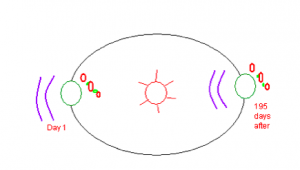
This year a peculiar formation of clouds observed in Kerala and many parts of South India on 27th and 28th February matched with the time of sudden spurt in rainfall 195 days later – i.e., on 8th and 9th August. It went for a week thereafter leading to the opening of the flood gates of all the dams in Kerala.
Pre-monsoon clouds in Kerala and other places.
From the evening of 27th February the sky was covered with clouds that looked like a blanket of neatly arranged bundles covering the entire sky from evening till next forenoon. The near full moon enhanced the cooling effect for the observer. The clouds looked like Cirrus but were low in the sky. Many weather enthusiasts reported this formation at that time. The picture below was taken in Kerala where this formation was thick and glowing in moonlight.
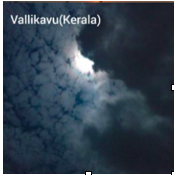
At the same time similar cloud formation was noticed across South India at many places.
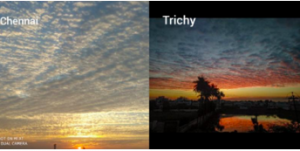
This formation coincided with a planetary combination of Mars in one sign and Mercury and Venus at 90 degrees away from Mars while Moon was in a watery sign.
Mars signifies heat. Mercury, Venus and Moon signify water (rainfall). This was a kind of presence of both heat and water together in the air at certain latitudes / at certain angle from the sun and these planets. The 195th day from the day of observation of these clouds was on August 8th and 9th – precisely the dates that saw a spurt in rainfall in Kerala to the extent of more than 300 mm in 24 hours at many places. Other regions of south India including Chennai received good rainfall on these days.
Another interesting feature is that Moon entered Aslesha after mid night of 27th when the clouds were still crossing the sky. Cloud formation on the day of Aslesha in the month of Magha would result in continuous rainfall for 16 days, according to Varahamihira. With Aslesha happening in the 2nd half, the rainfall went on for nearly a week in Kerala causing grave impact.
This real-time experience makes us take stock of what this wisdom is all about.
Hindu wisdom on clouds for prediction of rainfall.
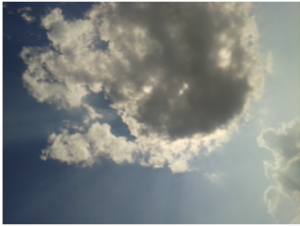
- In the four months mentioned above (observation period), cumulous clouds must be present in the sky in abundance. They should be seen with a halo around them.
- Around noon time huge and bulky clouds must be crossing the disc of the sun. They must look dark underneath for the observer on the ground.
- The clouds must be of the colour of pearl or silver. That means they must not be milk white, but of somewhat dull white.
- Shape of clouds also matters. Clouds must be of the shape of aquatic animals, like swans, crocodiles, fish, turtle and the like.
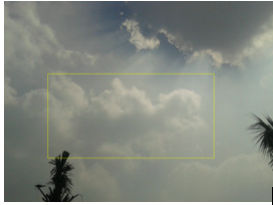
This is in contrast to mountain like, castle- like and animal like formations. Such formations must be seen in rainy season, and not in the observation period.
If clouds are seen with the above features in the observation period, it ensures good rainfall during monsoon period, subject to 195-day correlation. The clouds on 27th and 28th February were low and dark from below but not aquatic shaped. They looked low and dense, resembled cumulo-cirrus but never known to have been observed in the past. That makes the resultant rainfall rare and of destructive proportions.
Science behind these clouds.
In this backdrop let us take a look what science tells about the impact of clouds on rainfall. The linking of pre-monsoon clouds to 195-day-later rainfall is unknown to science. Only now the scientific community is waking up to the importance of clouds in affecting climate globally. A NASA publication says that “Scientists are gaining new insights into how clouds control atmospheric and surface temperature, atmospheric humidity, and atmospheric and oceanic circulation and precipitation patterns..”. The following illustration from the publication shows the contrasting effect of low and high level clouds.

The high clouds, or those in the nature of Cirrus clouds tend to contribute to warming of the earth, says the publication. As per astro-meteorology, the four months of observation must be cool, thereby indicating that clouds must be at the low level.
The same publication discusses the effect of low clouds.
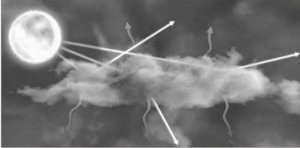
The above illustration shows low level clouds as controlling the solar radiation and reflecting them back. This keeps the ground cool.
Interestingly this is what is expected in the observation months. These months are expected to be foggy in the morning, followed by clouds forming in the sky as the sun climbs up. The slow heating and gentle winds expected in those months keep changing the shape of the clouds which appear as neck of the aquatic animals. (On these months one can observe swan shaped cloud becoming turtle shaped within minutes!) The incoming radiation is seen as a halo or glow around the clouds for the observer on land.
The difference between the scientific article and wisdom of sages is that science detects the conditions on the day of observation of the cloud but Hindu wisdom links it with the climatic conditions later. Its time our weather forecasters take a leaf out of this wisdom.
Dr. Jayasree Saranathan is a researcher, writer and astrologer with a Ph.D. in Astrology. Her research areas include Indology, Hindu Epics, Tamil Sangam literature and Astro-meteorology.
You can follower the author on Twitter @jayasartn




























 WhatsApp us
WhatsApp us
Pingback: ignou report
Pingback: Study in Uganda
Pingback: togel singapura
Pingback: taxis in the uk
Pingback: 안전카지노
Pingback: corey zieman reviews
Pingback: 안전바카라
Pingback: How To Use Wealthy Affiliate 2020
Pingback: kalpa pharma steroid reviews
Pingback: what website gives you answers to homework
Pingback: huong dan dang ky 12bet
Pingback: Buy sweets
Pingback: Harold Jahn Canada
Pingback: devops strategy
Pingback: RPA in Software Testing
Pingback: Online Reputation Management Consultants
Pingback: Oysters for sale online
Pingback: replica watch information
Pingback: Delta 25724LF manuals
Pingback: jpqryjer
Pingback: when is the best time to take viagra
Pingback: wat is de beste viagra
Pingback: azithromycin what kind of bacteria kill
Pingback: buy cialis
Pingback: viagra
Pingback: top 10 essay writing services
Pingback: write my research paper online
Pingback: writing my college application essay
Pingback: help me write my college application essay
Pingback: value system essay for business ethics
Pingback: augmentin 500 mg tablet price
Pingback: lasix 40
Pingback: zithromax 250 price
Pingback: stromectol how much it cost
Pingback: albuterol cheapest price
Pingback: doxycycline for horses
Pingback: prednisolone and ibuprofen
Pingback: clomid and mucinex
Pingback: priligy safe online
Pingback: diflucan 150mg fluconazole
Pingback: who makes synthroid
Pingback: propecia 0.25 mg
Pingback: chinese massage sexual dysfunction
Pingback: neurontin gabapentina
Pingback: metformin and glipizide
Pingback: withdrawel from paxil
Pingback: plaquenil icd 10
Pingback: tinder no phone number
Pingback: how much does cost with insurance
Pingback: 1000 calorie keto diet
Pingback: gay spiritual dating
Pingback: amoxicillin 500
Pingback: lasix 12.5
Pingback: neurontin 100mg caps
Pingback: plaquenil 200mg uk
Pingback: best prednisone
Pingback: priligy tablets
Pingback: buy provigil bangkok
Pingback: ivermectin 6mg dosage
Pingback: buying ventolin uk
Pingback: zithromax price
Pingback: plaquenil 150 mg
Pingback: super avana price
Pingback: ventolin 10 mg
Pingback: aralen cheapest
Pingback: nolvadex eu
Pingback: latisse buy
Pingback: 12mg tizanidine
Pingback: merck pill
Pingback: 2motorcycles